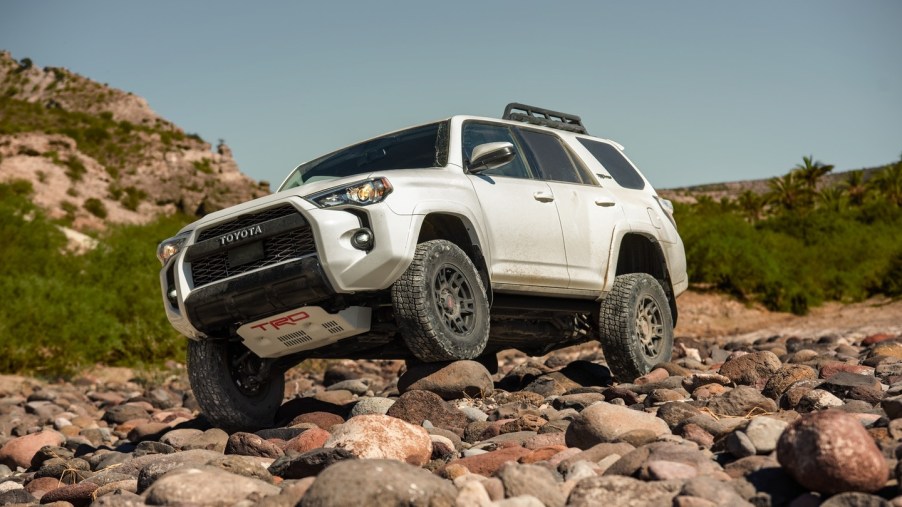
There’s a Big Difference Between Overlanding and Off-Roading
“Overlanding” and “off-roading” are often used interchangeably. And, to be fair, on the surface, the SUVs, trucks, and vans used for both activities can seem fairly similar. But if you’re interested in one or the other, know that off-roading and overlanding aren’t exactly the same thing. And just like the Jeep Wrangler can’t rally, an off-roader doesn’t necessarily make a good overlander.

Off-roading isn’t overlanding – but it requires certain necessities
Usually, people tend to turn toward trucks and body-on-frame SUVs when they want to go off-roading. The Jeep Gladiator and Wrangler, the Toyota Land Cruiser, 4Runner, Tacoma, and the Mercedes G-Wagon are all popular choices. But you don’t actually need a big, heavy vehicle.

Lancia won 6 World Rally Championships in a row with an all-wheel drive hatchback. Fiat sent its own four-wheel drive hatchback into the Paris-Dakar, as did Lada. And today, modifying Porsche 911s for off-roading is a popular trend. True, some vehicles are better suited for off-roading, but that doesn’t mean they can’t be modified to wander through mud and streams. Even something as small as a Japanese kei truck can go off-roading.

Essentially, the biggest concern is making sure obstacles, like rocks and tree roots, don’t damage your vehicle’s components. That’s why the most common off-road modification is lifting the vehicle up and installing bigger wheels and tires. Taller ride height, plus skid plates, means your fuel tank won’t get punctured.

That lift also requires a new suspension from a specialized supplier like Fox. This helps the off-roader absorb impacts from uneven surfaces better. It also lets it go over larger obstacles without slamming down and damaging itself.

If you’re going on a serious off-road trail like the Rubicon, it’s recommended to fit a winch. This lets you pull your off-roader free in case it gets stuck or helps you pull others free. For low-speed rock-crawling, solid axles are generally preferred over independent suspension. But that does worsen handling and ride comfort at high speeds, both on- and off-road.
All of this is also recommended for overlanding. But prepping an overlander requires more than just going off-road.
Overlanding involves off-roading – and requires more gear and mods
Off-roading is only part of overlapping. Basically, overlanding is traveling over vast distances via land, which most of the time will require driving on unpaved roads. However, off-roading is the type of driving you do once you’re on said routes. It’s kind of like the whole square-rectangle thing: Overlanding involves off-roading, but off-roading isn’t overlanding.
Team O’Neil Rally School put together a video to help explain the difference:
For example, going on the Rubicon Trail? That’s a difficult trail, but it is, in fact, a known off-roading trail. And, as Outside Magazine points out, modern off-roading usually involves a planned trail of some sort. Overlanding, meanwhile, is a multi-day journey that combines paved and unpaved routes. So, an overland route may include the Rubicon Trail, but only in one part. And because overlanding is done over multiple days in a variety of environments, more gear and modifications are required.
You need a camper or some other sleeping area, for example, as well as somewhere to cook food. That’s why vans like the Mitsubishi Delica are popular with overlanders: they have the interior space for a mini kitchen and bed. The route will also require some pavement time, so the vehicles have to be road-legal, which means no Sherps.
I would take a Mitsubishi Pajero Evolution SUV or Safari 911 off-road, but if I was going overlanding, I’d rather have a Delica. But that’s not to say I couldn’t turn a Pajero Evolution into an overlander.
Can one vehicle do both?
Because overlanding vehicles must, by definition, be able to go off-roading, there’s no reason why you couldn’t prep one vehicle for both.
However, large campers like those built on Unimogs and Ford Super-Duties will struggle on smaller, more technical trails. And because overlanding vehicles have to balance on-road comfort with off-road ability, some compromises are inevitable.
But, there are a number of vehicles that are popular with both off-roaders and overlanders. Land Cruisers are a popular choice, though unibody SUVs like the Ford Expedition have also been modified for overlanding and off-roading. There are also vans like the Mitsubishi Delica and Volkswagen Vanagon Synchro. Outside Magazine even reports that wagons like the Subaru Forester have been turned into overlanders.
Off-roading isn’t quite the same as overlanding, but that doesn’t mean you can’t use one vehicle to enjoy both.
This article was originally published on February 17, 2020. It was updated on May 29, 2024, for freshness.


